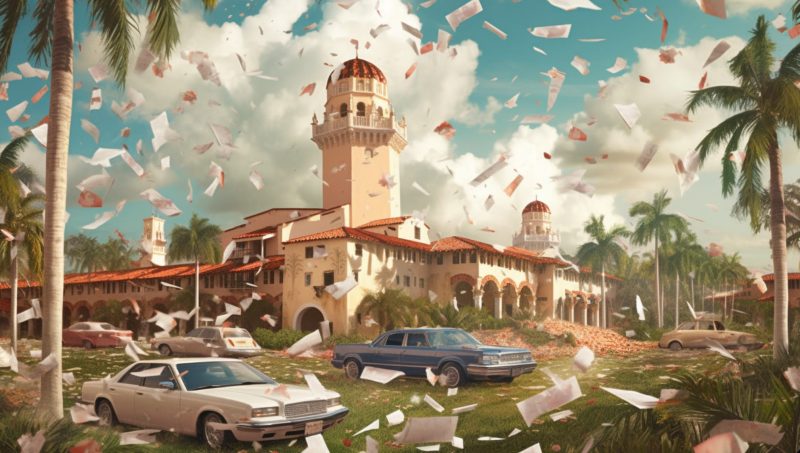
Emerging Information Suggests a ‘Dry Run’ for Relocation of Sensitive Documents, Highlighting Donald Trump’s Alleged Directives and Intentions.
The Mar-a-Lago Club in Palm Beach, Florida, found itself at the center in a series of bewildering occurrences. A saga unfolded, revealing a narrative of intrigue and suspicion centered around the former president, Donald Trump. The players: Trump’s employees, the FBI, the Justice Department, and a host of classified documents at the heart of this swirling maelstrom.
It began with a seemingly ordinary act. Two employees working for Trump transferred boxes of documents, an act as mundane as any on a regular day. However, the timing of this transfer, a day prior to the arrival of FBI agents and a prosecutor, ignited the spark of suspicion that has since evolved into a full-blown investigation. This simple action, innocent in isolation, when juxtaposed against the backdrop of the imminent Justice Department’s visit, has drawn intense scrutiny.
The undercurrents of this investigation hint at the possibility of obstruction. One may ask, was this an earnest attempt by diligent workers to organize documents? Or, was it a strategic move, a chess play intended to thwart the looming Justice Department’s visit? Knowing Trump we think we can be pretty sure it was obstruction.
The story takes an intriguing turn with the mention of an alleged ‘dress rehearsal’. According to sources, Trump and his aides simulated the movement of sensitive papers before the arrival of a subpoena in May 2022. These series of events, shrouded in ambiguity, extend the timeline of potential obstruction instances being scrutinized.
The origin of this investigative quagmire lies in a subpoena issued in May 2022. It asked for the retrieval of classified documents that remained in Trump’s possession post his presidency. Classified documents that should have been returned to the government found their way into storage areas at Mar-a-Lago, and in some cases, into Trump’s office. These actions beg the question: what was Trump’s intent in holding onto these hundreds of classified documents after his White House departure?
The actions post the subpoena issued in May 2022 provide a critical narrative in this investigation. Evidence suggests boxes were shifted out of the storage area following the subpoena. However, the timeline and context of this movement have proven to be significant in the investigation. The question remains: was this action purely administrative, or does it have darker implications?
As the Justice Department delves deeper, the grand jury activity surrounding the case has seen a slowdown in recent weeks. Simultaneously, Trump’s attorneys have begun outlining potential defenses to members of Congress and seeking a meeting with the attorney general. These actions indicate the anticipation of a potential charging decision looming on the horizon.
Meanwhile, Jack Smith, the special counsel appointed by Attorney General Merrick Garland, continues to scrutinize Trump’s efforts to block the 2020 election results. Additionally, Trump finds himself embroiled in other legal challenges. He faces indictment in New York for allegedly falsifying business records and an election-related investigation in Fulton County, Ga.
The plot thickens with the FBI’s raid at Mar-a-Lago on August 8. The raid followed months of unsuccessful efforts to retrieve classified documents from Trump’s residence. During the raid, the FBI discovered over 100 additional classified documents scattered in Trump’s office and the storage area, throwing a wrench in the defense’s claim that all relevant documents had been turned over.
A significant breakthrough came in the form of a ‘dress rehearsal’. Before the subpoena arrived, Trump and his legal team purportedly reviewed the contents of some boxes containing classified material. The ‘dress rehearsal’ was aimed at ensuring Trump could retain papers he deemed as personal property. This intriguing discovery provides investigators with a fresh angle to pursue potential ulterior motives in Trump’s actions.
Meanwhile, Inside Trump’s Florida office, the picture painted is even more intriguing. Witnesses suggest that classified documents were kept visibly around the office, sometimes being shown to aides and visitors alike. Trump’s open display of these sensitive documents adds another layer to the investigation, questioning whether he understood he possessed classified material.
One might wonder why these classified documents, usually locked away in secured vaults, were so readily available to any curious eye in Trump’s office. This unusual practice could severely undermine claims by Trump and his legal team about his lack of knowledge regarding the classified documents.
The investigation into this enigmatic series of events is meticulously deconstructing the layers of actions and intentions. It has identified several suspected instances of obstructionist conduct, with one of these suspected instances occurring after the FBI’s search on August 8.
Additionally, a curious detail emerged. In December, Trump’s lawyers found a box of White House schedules, some marked as classified, at Mar-a-Lago. The box had been moved from a government-leased office in nearby West Palm Beach by a junior aide. This event provides another breadcrumb for investigators to follow on this convoluted trail.
As the saga continues, it is evident that the events at Mar-a-Lago are steeped in a dizzying blend of intrigue and confusion. Every detail, from the movement of boxes to the unusual presence of classified documents in Trump’s office, contributes to a swirling storm of questions.
The investigations, albeit slow and meticulous, are gradually shedding light on this labyrinthine narrative. Yet, much remains to be understood. The apparent layers of complexity surrounding the case promise to keep investigators, lawyers, and the public engaged as the tale continues to unravel.
Now we wait for Jack Smith to make his next move, which most experts think will be an indictment.
